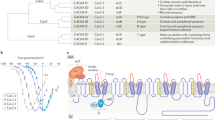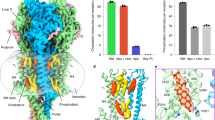Abstract
ADENOSINE is a potent modulator of transmitter release at a variety of synapses. The adenosine Al receptor is assumed to reside in presynaptic terminals and to function as a negative autoreceptor1. How adenosine reduces transmitter release is uncertain2; it may reduce the calcium influx during nerve terminal depolarization by either activating K+ currents3,4 or inhibiting Ca2+ currents5,6, although other mechanisms have been proposed7–9. We have directly measured intracellular Ca2+ concentrations of giant presynaptic terminals in the chick ciliary ganglion. We report here that adenosine inhibited the nerve-evoked Ca2+ influx in the termi-nal by activating Al receptors. Reduced Ca2+ influx was due largely to inhibition of ω-conotoxin GVIA-sensitive Ca2 + channels in the presynaptic terminal.
This is a preview of subscription content, access via your institution
Access options
Subscribe to this journal
Receive 51 print issues and online access
$199.00 per year
only $3.90 per issue
Buy this article
- Purchase on Springer Link
- Instant access to full article PDF
Prices may be subject to local taxes which are calculated during checkout
Similar content being viewed by others
References
Nicoll, R. A., Malenka, R. & Kauer, J. A. Physiol. Rev. 70, 513–565 (1990).
Greene, R. W. & Haas, H. L. Progr. Neurobiol. 36, 329–341 (1991).
Trussell, L. O. & Jackson, M. B. Proc. natn. Acad. Sci. U.S.A. 82, 4857–4861 (1985).
Gerber, U., Greene, R. W., Haas, H. L. & Stevens, D. R. J. Physiol., Lond. 417, 567–578 (1989).
Hamilton, B. P. & Smith, D. O. J. Physiol., Lond. 432, 327–341 (1991).
Scholz, K. P. & Miller, R. J. J. Physiol., Lond. 435, 373–393 (1991).
Silinsky, E. M. Trends pharmac. Sci. 7, 180–185 (1986).
Scholz, K. P. & Miller, R. J. Neuron 8, 1139–1150 (1992).
Silinsky, E. M. & Solsona, C. S. J. Physiol., Lond. 457, 315–328 (1992).
Bennett, M. R. & Ho, S. J. Physiol., Lond. 440, 513–527 (1991).
Snyder, S. H. A. Rev. Neurosci. 8, 103–124 (1985).
Branisteanu, D. D., Haulica, I. D., Proca, B. & Nhue, B. G. Naunyn-Schmiedeberg's Arch. Pharmacol. 308, 273–279 (1979).
Scanziani, M., Capogna, M., Gahwiler, B. G. & Thomposon, S. M. Neuron 9, 919–927 (1992).
Schilling, W. P., Rajan, L. & Strobl-Jager, E. J. biol. Chem. 264, 12838–12848 (1989).
Kwan, C.-Y. & Putney, J. W. Jr J. biol. Chem. 265, 678–684 (1990).
Yawo, H. & Momiyama, A. J. Physiol., Lond. 460, 153–172 (1993).
Dodge, F. A. Jr & Rahamimoff, R. J. physiol., Lond. 193, 419–432 (1967).
Yawo, H. J. Physiol., Lond. 417, 307–322 (1989).
Shimahara, T., Icard-Liepkalins, C., Ohmori, H. & Shigemoto, T. Brain Res. 524, 219–224 (1990).
Grynkiewicz, G., Poenie, M. & Tsien, R. Y. J. biol. Chem. 260, 3440–3450 (1985).
Haugland, R. P. in Handbook of Fluorescent Probes and Research Chemicals 5th edn 114 (Molecular Probes Inc., Eugene, 1992).
Hamill, O. P., Marty, A., Neher, E., Sakmann, B. & Sigworth, F. J. Pflügers Arch. 391, 85–100 (1981).
Author information
Authors and Affiliations
Rights and permissions
About this article
Cite this article
Yawo, H., Chuhma, N. Preferential inhibition of oω-conotoxin-sensitive presynaptic Ca2+ channels by adenosine autoreceptors. Nature 365, 256–258 (1993). https://doi.org/10.1038/365256a0
Received:
Accepted:
Issue Date:
DOI: https://doi.org/10.1038/365256a0
This article is cited by
-
Adenosine receptor signalling in Alzheimer’s disease
Purinergic Signalling (2022)
-
Mdivi-1 Protects Against Ischemic Brain Injury via Elevating Extracellular Adenosine in a cAMP/CREB-CD39-Dependent Manner
Molecular Neurobiology (2016)
-
Ethanol-Induced Cerebellar Ataxia: Cellular and Molecular Mechanisms
The Cerebellum (2015)
-
The role of ATP and adenosine in the brain under normoxic and ischemic conditions
Purinergic Signalling (2007)
Comments
By submitting a comment you agree to abide by our Terms and Community Guidelines. If you find something abusive or that does not comply with our terms or guidelines please flag it as inappropriate.



